
|
 |
||||||
|---|---|---|---|---|---|---|---|
| Avro Lancaster |
 |
 |
 |
 |
 |
||
 |
 |
 |
 |
 |
|||
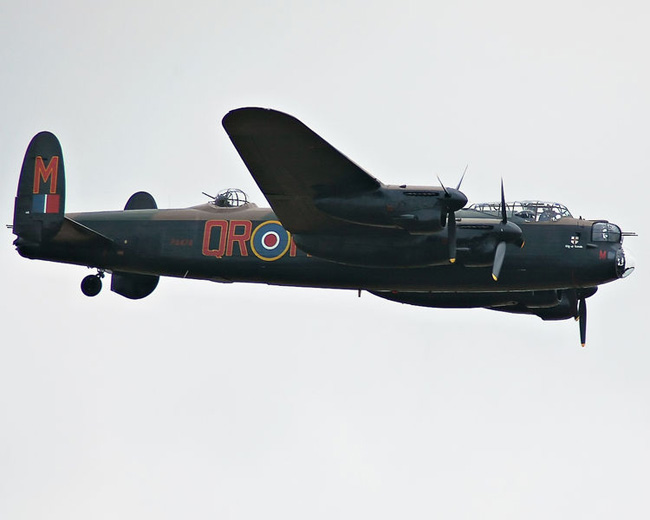 |
|||
|
The Avro Lancaster the most famous of all Avro military aircraft, and without doubt the most successful heavy night bomber to be deployed over Europe, during World War II. | |||
| Under the cover of darkness, on May 17, 1943, nineteen Lancaster heavy bombers of Royal Air Force Bomber Command, flew over the coast of occupied Europe on a most secret mission. The crews were specially trained and the aircraft specially prepared to carry barrel shaped bombs designed by Barnes Wallis. As the targets loomed closer, the designated aircraft initiated their attack runs at very low altitude. The first Lancaster released its bomb, followed by the other aircraft in its group, and as each pulled away the crew could see the bomb bouncing along the surface of the lake towards its concrete target, striking it and finally sinking and exploding. Back at base the news broke—Lancasters of 617 Squadron had breached the Moehne, Eder and Sorpe dams in northwest Germany, and had caused major flooding of the vital Ruhr Valley industrial area. The floods had drowned some 1,200 German workers, but the cost was high with the loss of eight RAF Lancaster bombers and crews. This daring venture, and the sinking of the German battleship Tirpitz in a Norwegian fjord in 1944, are the best known of all the exploits of the Lancaster, yet it was as the ceaseless night-time destroyer of German industrial centers and cities that it did most to bring the war to a close. |
|
The Lancaster bomber holds a special place of affection mingled with a great
deal of pride in the hearts of British and Commonwealth citizens—feelings
which perhaps find their parallel in the hearts of Americans toward the
B-17 Flying Fortress. Just as the
Spitfire epitomized the Commonwealth's
supreme spirit of defiance in the face of seemingly irresistible defeat, so
the evening sight and sound of streams of Lancasters "heading out" toward
the heartland of the German Reich was the ultimate translation of a war
weary people's will to see the Nazi military and industrial machine—the
source of colossal suffering for so much of the world—battered into
oblivion.
The Lancaster flew for the first time on January 9, 1941 as a four-engine development of the Avro Manchester. The RAF began to equip with Mk Is in early 1942, and used them first on March 10th against targets in Essen. Altogether, more than 7,300 Lancasters were produced in Britain as Mks I to VII and in Canada as Mk Xs, and they dropped more than 608,000 tons of bombs on 156,000 wartime missions. Some Lancasters were still flying with the RAF in the early 1950s as maritime-reconnaissance, photo-reconnaissance and rescue aircraft. Like all successful aircraft, the Lancaster not only looked good but its flying characteristics matched its appearance. It is all the more ironic therefore that the birth of Avro's mighty machine owed so much to failure, the failure of its immediate predecessor, the twin engine Avro Manchester. The Avro 683 evolved almost accidentally as a result of recurrent failure of the insufficiently developed Rolls Royce Vulture engines installed on the Manchester. |
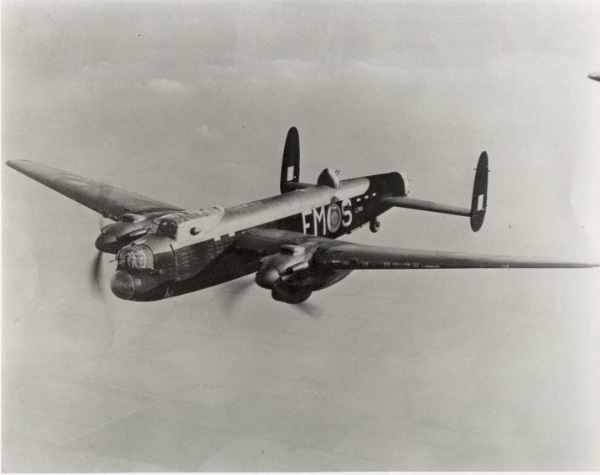 |
|
The Avro 679 Manchester was the predecessor to the Lancaster, which performed poorly due to the inadequacies of its Rolls Royce Vulture engines. |
|
In May 1936, Group Captain R.D. Oxland, Director of the Air Ministry's Operational
Requirements, issued specification P.131/36 for a twin engine bomber capable of carrying
internally a 12,000 lb maximum bomb load, or a single 8,000 lb bomb, or a pair of torpedoes.
Two firms were invited to build prototypes of their design submissions, Handley Page submitted the HP 56
and Avro the 679. During the trials, the HP 56 was rejected, because of a projected shortage of
Rolls-Royce engines. Within weeks of Avro receiving a prototype order, a production order was
placed for 200 machines to the new Specification 191/37.
Large when compared with other twin engine aircraft the P.131/36 was actually powered by four Rolls-Royce engines. Under the designation Vulture, Rolls-Royce had mated a pair of V12 cylinder Kestrel engines with a common crankcase creating a 24 cylinder "X" engine and a lot of trouble. On July 25, 1939, the prototype, L7246 was flown for the first time with Group Captain H.A. Brown at the controls. While airborne for only 17 minutes, it was long enough to realize that the Vulture engines were turning out much less power than anticipated and wing loading made the aircraft extremely difficult to fly. To correct lateral instability a central fin was added to the second prototype, L7247, which flew for the first time on May 26,1940. The second machine was armed with six .303 Browning machine guns, two in the nose, ventral and tail turrets. Production quickly followed with the first production machine, L7276, rolling out on August 5, 1940 during the height of the Battle of Britain. Production machines had a wing span increase and the ventral turret was removed to the dorsal position. The need for additional modifications and the urgency of manufacturing fighters slowed down production of the P.13136, which was now known as the Manchester. L7277. The second production machine, was not delivered until October 25, 1940. |
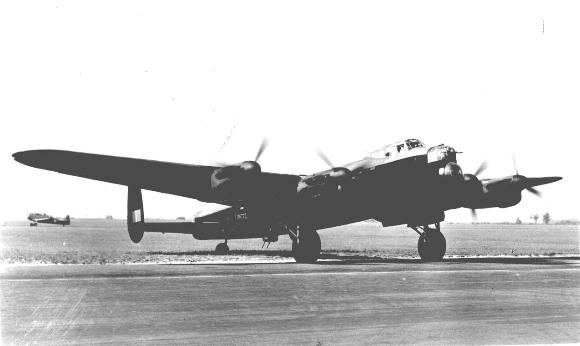 |
|
Avro Lancaster B Mk. I
|
|
This second production machine was delivered to No. 207 Squadron at Waddington under the
command of Wing Commander Hyde, which had been reformed to work up the still secret
Manchester. By the end of the year, No. 207 Squadron had received some
twenty machines. On January 9, 1941, the existence of the Manchester was
revealed to the full RAF and on February 24,
six Manchesters were part of the attacking force raiding Brest where a Hipper class cruiser was
reported. All machines returned safely, but L7284 crash landed at Waddington when the hydraulic
system failed. Trouble with the hydraulic system persisted, but was eventually traced to an oil leak
which fouled the undercarriage micro switches and was corrected.
Problems with the Vulture power plants were not so easily solved however, and No. 207 Squadron seldom had more than five machines serviceable at one time. On the night of March 13, 1941, the first Manchester was lost to enemy action when L7319 was shot down shortly after takeoff from Waddington by Feld W. Hans Hahn of I/NJG 2. Most of the Manchester's mechanical problems by now had been solved and a second assembly line, at Metropolitan Vickers, which began turning out machines for the new Squadrons being formed. The basic problem with the Manchester, that of being underpowered, was still to be addressed. With a service ceiling of only 10,000 feet, the loss of one engine resulted in an almost immediate loss of height. The poor performance of the Manchester caused one squadron to (only half-jokingly) plan their squadron reunion in POW camp. In April, all Manchesters were grounded when faults were found in the Vulture engine bearings. On June 16, the Manchesters were again grounded to modify the cooling system, and again on June 30 for complete engine overhauls and testing, the results of which were a further series of modifications. On August 7, operations were resumed at which time two further faults showed up. The tail flutter, which was eventually corrected by redesigning the tail to an enlarged twin fin configuration under the designation Manchester IA, and the propeller feathering problem which was not so easily traced. Engine problems seemed to increase rather than abate and casualties grew. During initial trials of the Manchester prototype, it had been quickly realized that the 24 cylinder Vultures were not turning out the anticipated power. Two projects were initiated to correct the situation, replacement of the Vultures with a pair of Napier Sabre or Bristol Centaurus engines, keeping the twin engine configuration under the designation Manchester Mk II, or by reconfiguring the aircraft to a four engine machine under the designation Manchester Mk III. The four engine solution was completed first, and so successfully that the twin engine projects were dropped out of hand. |
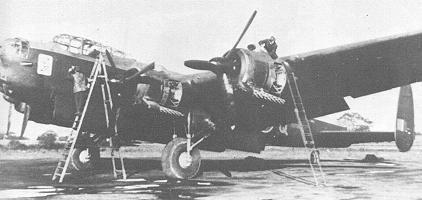 |
|
Only 300 Lancaster IIs were built with 1,650 hp
Bristol Hercules VI radial engines.
|
|
Owing to delays in the full development of the Vulture engine, the
decision was taken in mid 1940 to design a new version of the Manchester
with four
Rolls-Royce Merlin engines. The first conversion made use
of about 75 per cent of the Manchester's parts and assemblies, the principal
change being the provision of a new center section of the wing with
mountings for Merlin engines. This aircraft became the first
prototype of the Lancaster. A second prototype fitted with Merlins and
significantly modified in detail was designed, built and flown in just eight
months. The first production Lancaster I flew just over five months later,
its power plant comprising similar 954 kW (1,280 hp) Rolls-Royce Merlin XX
Vee, liquid-cooled engines, each driving a three-blade constant-speed and
fully feathering propeller. Because of the possibility of some interruption
in Merlin production, the Lancaster II was built with 1,230 kW (1,650 hp)
Bristol Hercules VI radial engines. These fears did not materialize,
with the result that only 300 Lancaster IIs were built.
BT308, a standard Manchester airframe, was fitted with a new wing center section into which were installed four of the very reliable Rolls-Royce Merlin X engines. Flying for the first time on January 9, 1941, that flight was enough to convince Roy Dobson and his designers that true success had been achieved. The doubling from two to four motors meant an increase in the Manchester's maximum bomb load, from 10,350 lbs to an operational average of 12,000/14,000 lbs. Fuel capacity was increased from 1,700 to 2,154 gallons and range increased from 1,200 miles to 2,350 miles. Bomber Command now had a bomber that could penetrate deep into Nazi occupied Europe with a much larger bomb load and could reasonably expect to evade or fight off all that the enemy could provide in defensive measures—and at an altitude more than double the Manchester's meager 10,000 foot ceiling. Of even more importance to the crews flying the bomber into enemy air space was the security afforded them by the reliability of the newly installed Merlin power plants. Official testing at Boscombe Down during March found that the elevators and ailerons responded well at either end of an I.A.S. range of 100 to 290 mph, but rudder pressure did increase with speed. The strong tendency to swing to port during takeoff was solved by advancing the port-outer throttle and raising the tail quickly, to allow the pilot to bring the rudders into play. In May the second prototype, DG595, took to the air. In contrast to BT308, she carried both mid-upper and ventral turrets and a newly designed and enlarged twin tail configuration which discarded the center fin. New 1,280 HP Merlin XX engines had been installed in place of the earlier Merlin Xs. The RAF now had a bomber with which it could wage war in Germany. There would be no more talk around the squadrons about reunions in POW camp! |
|
Avro lancaster I - "Admiral Prune," 106 Sq., Syerston November 1942 | |
| Guy Gibson | 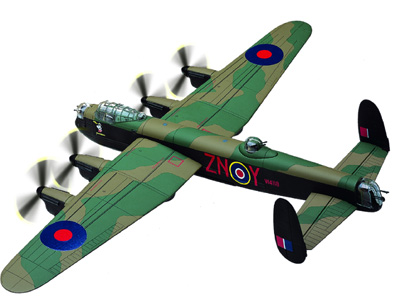 |
|---|---|
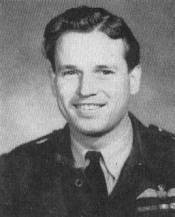 |
|
| Photo from 617 Squadron the "Dambusters" | |
| In 1942 Guy Gibson expressed a desire to return to Bomber Command, and he soon received a telegram asking him to report for an interview with the newly appointed C-in-C Bomber Command, "Bomber" Harris. Apparently the interview must have gone well because two days later another telegram arrived telling him he was to command the 106th Bomber Squadron at Coningsby, in Lincolnshire. Gibson named his aircraft "Admiral Prune," and the aircraft's side was decorated with a Mickey Mouse figure with bombs underneath, depicting the number of trips the aircraft carried out. | |
|
First operational RAF squadron to be equipped with Lancasters was No 44, which used them operationally for the first time on March 3, 1942 laying mines in the Heligoland Bight. Defended by ten machine-guns and carrying a maximum bomb load of 6,350 kg (14,000 lb). The Lancaster was, and soon proved itself to be a formidable weapon in the hands of the RAF, which had, by mid 1942, learned a great deal about night bombing operations over Europe. By comparison with contemporary four-engined bombers it was statistically the most effective, dropping 132 tons of bombs for each aircraft lost on operations; the corresponding figure for the Halifax and Stirling were 56 and 41 tons respectively. The Lancaster was so right from the beginning that there were very few changes in airframe design during its wartime service. Improved power plants, however, provided steadily improving performance: the Lancaster VII, for example, with 1,207 kW (1,620 hp) Merlin 24 engines, had a maximum takeoff weight of 30,844 kg (68,000 lb) by comparison with the 22,680 kg (50,000 lb) of the early Is. Bomb load changed considerably, the cavernous bomb bay being designed originally to carry bombs of up to 4,000 lb, with a total bomb load of 6,350 kg (14,000 lb); it was modified progressively to carry the 22,000 lb Grand Slam bomb.
The Lancaster will be remembered for its part in two spectacular operations: the breaching of the Mohne and Eder dams on the night of May 16-17,1943 by No 617 Squadron (led by Wing Cdr. Guy Gibson); and the sinking of the German battleship Tirpitz Its contribution to victory in World War II is best measured, however, by the total of 608,612 tons of bombs delivered, which represented two-thirds of the total bomb load dropped by the RAF from the time of its entry into service. A total of 7,366 Lancasters were built (including Mk Xs in Canada) and the type remained in front-line service with the RAF until 1954. Canada had some photo-reconnaissance Lancasters in service in 1964. |
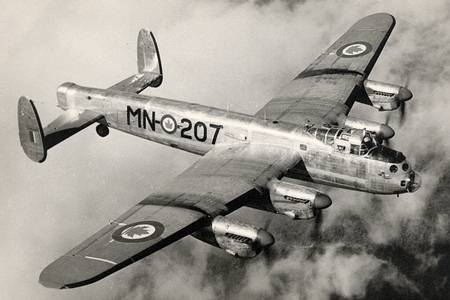 |
|
Manufactured by Victory Aircraft in 1945, converted by Avro Canada to Mk.19P in 1949. This aircraft was retired on September 29, 1962. |
| Specifications: | |
|---|---|
| Lancaster I | |
| Dimensions: | |
| Wing span: | 102 ft 0 in (31.09 m) |
| Length: | 69 ft 4 in (21.13 m) |
| Height: | 19 ft 7 in (5.97 m) |
| Weights: | |
| Empty: | 36,900 lb. (16,738 kg) |
| Normal: | 53,000 lb (24,062 kg) |
| Performance: | |
| Maximum Speed: | 287 mph (462 km/h) |
| Service Ceiling: | 24,500 ft. (7,470 m) |
| Range: | 1,660 miles (2,670 km) |
| Powerplant: | |
|
Four 954.5 kW (1,280 hp) Rolls-Royce Merlin 24s 12 cylinder Vee engines. | |
| Armament: | |
|
Ten 0.303 in machine-guns and up to 14,000 lb (6,350 kg) of bombs, maximum one 22,000 (9,988) bomb. | |
| RAF Bomber Sorties and Losses: | |
|---|---|
| 1939 - 1945 | |
| Night sorties: | 297,663 |
| Losses: | 7,449 |
| Day sorties: | 876 |
| British and American Bomber Offensive against Germany | |
|---|---|
| 1939 - 1945 | |
| RAF Bomber Command | |
| 1939 | 31 tons |
| 1940 | 13,033 tons |
| 1941 | 31,504 tons |
| 1942 | 45,561 tons |
| 1943 | 157,457 tons |
| 1944 | 525,518 tons |
| 1945 | 191,540 tons |
| Total: | 964,644 tons |
| U.S. 8th Air Force | |
| 1939 | - |
| 1940 | - |
| 1941 | - |
| 1942 | 1,561 tons |
| 1943 | 44,165 tons |
| 1944 | 389,119 tons |
| 1945 | 188,573 tons |
| Total: | 623,418 tons |
© The Aviation History On-Line Museum.
All rights reserved.
Created May 19, 2007. Updated May 24, 2015.